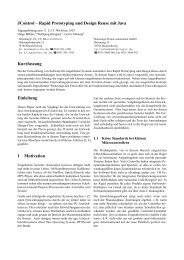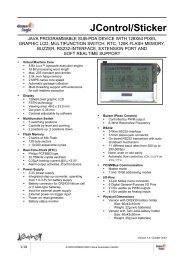JControl/SmartDisplay - DOMOLOGIC Home Automation GmbH
JControl/SmartDisplay - DOMOLOGIC Home Automation GmbH
JControl/SmartDisplay - DOMOLOGIC Home Automation GmbH
Create successful ePaper yourself
Turn your PDF publications into a flip-book with our unique Google optimized e-Paper software.
Fig. 3 gives an overview of bank 0’s internal<br />
structure: Application software is written upwards,<br />
starting at physical sector 0 and non-volatile data<br />
is stored downwards, starting at physical sector<br />
510 (resp. 254 for devices with four flash banks).<br />
Logical Sector<br />
Sector 0<br />
Sector 1<br />
Sector 2<br />
Fig. 3: Internal Structure of Flash bank 0<br />
(For Devices with 1 or 2 Flash Banks with<br />
512 Sectors per Bank)<br />
DOWNLOAD MODE<br />
The system download mode is a fundamental<br />
functionality of the JCVM8, implemented in every<br />
<strong>JControl</strong> device. It is used for uploading<br />
application software to and downloading data from<br />
the Flash memory by a host computer, for auto<br />
identification of the <strong>JControl</strong> device and for<br />
reading or writing system properties by remote.<br />
The download mode is used e.g. by the<br />
development tools like <strong>JControl</strong>/IDE and<br />
PropertyEdit.<br />
The system download mode may be entered by<br />
one of following four cases:<br />
(1) Directly after the initialization sequence of the<br />
JCVM8: If no valid application software is<br />
available in bank 0 of the Flash memory, the<br />
device enters the system download mode.<br />
(2) During normal operating conditions: If the<br />
virtual machine is restarted by the method<br />
switchBank() of the built-in class<br />
jcontrol.system.Management and the<br />
new Flash bank contains no valid application<br />
software.<br />
GND<br />
<strong>JControl</strong>/<strong>SmartDisplay</strong><br />
Physical Sector<br />
Sector 511<br />
Sector 510<br />
Sector 509<br />
Sector 2<br />
Sector 1<br />
Sector 0<br />
KB_IN<br />
Fig. 5: Entering the System Download Mode<br />
� Pull signal KB_IN to GND (Pin 13), � activate RESET<br />
signal for more than 10ms (Pin 22)<br />
VCC<br />
+5V<br />
RESET<br />
"RESET"<br />
Properties<br />
Nonvolatile<br />
Data<br />
Application<br />
Software<br />
4/18 © 2003-2006 <strong>DOMOLOGIC</strong> <strong>Home</strong> <strong>Automation</strong> <strong>GmbH</strong><br />
<strong>JControl</strong>/<strong>SmartDisplay</strong><br />
This procedure reduces the possibility of resource<br />
conflicts between application software and data.<br />
To offer a linear ascending number of sectors<br />
(starting at sector 0) to the application, the class<br />
jcontrol.io.Flash maps access to the logical<br />
sector 0 to the physical sector 510 of the Flash<br />
memory, access to logical sector 1 to the physical<br />
sector 509 and so on. The uppermost sector of<br />
bank 0 (sector 511) is used to hold non-volatile<br />
system properties. The same principle is also<br />
used for Flash Bank 1, except that the uppermost<br />
sector is not holding the system properties.<br />
For applications using the flash memory<br />
independently of the memory architecture, the<br />
external class jcontrol.storage.<br />
FlashStream is provided. It represents a<br />
memory cached data stream for reading and<br />
writing continuous data to or from the non-volatile<br />
flash memory.<br />
Fig. 4: Splash screen of the system download mode<br />
(3) The system download mode may be enforced<br />
by pulling Pin 13 (GPIO #9/KB_IN) to GND<br />
while resetting the device (as shown in Fig. 5).<br />
Refer to the chapter covering the Analog<br />
Keyboard.<br />
(4) The mode may also be started by software<br />
calling the run()-Method of an instance of<br />
the built-in class<br />
jcontrol.system.Download.<br />
In the first three cases, a splash screen appears<br />
as shown in Fig. 4. The first line of the splash<br />
screen gives information about the <strong>JControl</strong><br />
device profile (“<strong>JControl</strong>/<strong>SmartDisplay</strong>”). The<br />
second line shows the build date of the JCVM8,<br />
represented as format yyyyMMddhhmm<br />
(yyyy=year, MM=month, dd=day, hh=hour,<br />
mm=minute). The following “+0100” in the example<br />
is optional and gives information about the time<br />
zone. The build date is also available as system<br />
property profile.date and used by the tools to<br />
select an appropriate device profile. The bottom<br />
line shows the parameters of the RS232 interface,<br />
fixed to 19200 bps, 8 data bits, no parity and 1<br />
stop bit.






